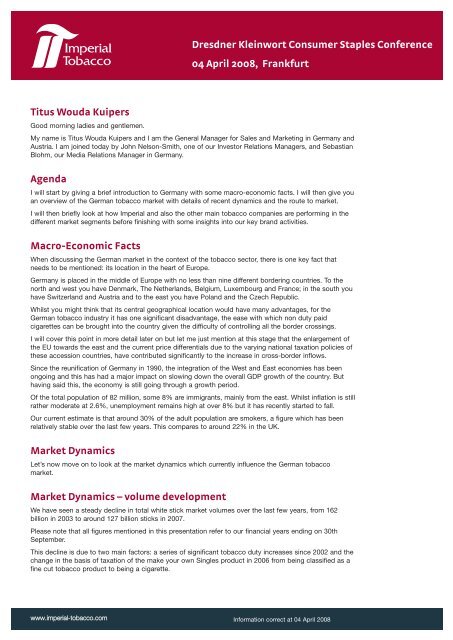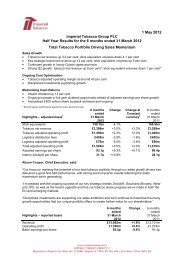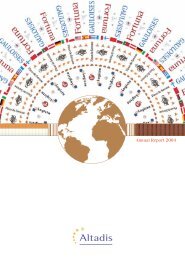Dresdner Kleinwort Consumer Staples ... - Imperial Tobacco
Dresdner Kleinwort Consumer Staples ... - Imperial Tobacco
Dresdner Kleinwort Consumer Staples ... - Imperial Tobacco
Create successful ePaper yourself
Turn your PDF publications into a flip-book with our unique Google optimized e-Paper software.
Titus Wouda Kuipers<br />
Good morning ladies and gentlemen.<br />
My name is Titus Wouda Kuipers and I am the General Manager for Sales and Marketing in Germany and<br />
Austria. I am joined today by John Nelson-Smith, one of our Investor Relations Managers, and Sebastian<br />
Blohm, our Media Relations Manager in Germany.<br />
Agenda<br />
I will start by giving a brief introduction to Germany with some macro-economic facts. I will then give you<br />
an overview of the German tobacco market with details of recent dynamics and the route to market.<br />
I will then briefly look at how <strong>Imperial</strong> and also the other main tobacco companies are performing in the<br />
different market segments before finishing with some insights into our key brand activities.<br />
Macro-Economic Facts<br />
When discussing the German market in the context of the tobacco sector, there is one key fact that<br />
needs to be mentioned: its location in the heart of Europe.<br />
Germany is placed in the middle of Europe with no less than nine different bordering countries. To the<br />
north and west you have Denmark, The Netherlands, Belgium, Luxembourg and France; in the south you<br />
have Switzerland and Austria and to the east you have Poland and the Czech Republic.<br />
Whilst you might think that its central geographical location would have many advantages, for the<br />
German tobacco industry it has one significant disadvantage, the ease with which non duty paid<br />
cigarettes can be brought into the country given the difficulty of controlling all the border crossings.<br />
I will cover this point in more detail later on but let me just mention at this stage that the enlargement of<br />
the EU towards the east and the current price differentials due to the varying national taxation policies of<br />
these accession countries, have contributed significantly to the increase in cross-border inflows.<br />
Since the reunification of Germany in 1990, the integration of the West and East economies has been<br />
ongoing and this has had a major impact on slowing down the overall GDP growth of the country. But<br />
having said this, the economy is still going through a growth period.<br />
Of the total population of 82 million, some 8% are immigrants, mainly from the east. Whilst inflation is still<br />
rather moderate at 2.6%, unemployment remains high at over 8% but it has recently started to fall.<br />
Our current estimate is that around 30% of the adult population are smokers, a figure which has been<br />
relatively stable over the last few years. This compares to around 22% in the UK.<br />
Market Dynamics<br />
Let’s now move on to look at the market dynamics which currently influence the German tobacco<br />
market.<br />
Market Dynamics – volume development<br />
We have seen a steady decline in total white stick market volumes over the last few years, from 162<br />
billion in 2003 to around 127 billion sticks in 2007.<br />
Please note that all figures mentioned in this presentation refer to our financial years ending on 30th<br />
September.<br />
This decline is due to two main factors: a series of significant tobacco duty increases since 2002 and the<br />
change in the basis of taxation of the make your own Singles product in 2006 from being classified as a<br />
fine cut tobacco product to being a cigarette.<br />
www.imperial-tobacco.com<br />
<strong>Dresdner</strong> <strong>Kleinwort</strong> <strong>Consumer</strong> <strong>Staples</strong> Conference<br />
04 April 2008, Frankfurt<br />
Information correct at 04 April 2008
www.imperial-tobacco.com<br />
<strong>Dresdner</strong> <strong>Kleinwort</strong> <strong>Consumer</strong> <strong>Staples</strong> Conference<br />
04 April 2008, Frankfurt<br />
There were five successive duty increases between 2002 and 2005 by at least one euro cent per stick<br />
each time. These had a significant impact on duty-paid volumes as consumers switched to legal and<br />
illegal imports. However, the overall rate of decline in consumption is similar to that in other western<br />
European countries.<br />
However, one of the positive trends to have taken place in recent years from our point of view, is the<br />
decrease in the level of Private Label factory made cigarettes.<br />
Whilst it is our policy to have at least one of our brands in each price segment, in this environment, it is<br />
tremendously important to offer the price-sensitive consumer quality products at an attractive price.<br />
Following the change in the taxation of Singles, we saw a further shift from duty-paid OTP volumes to<br />
legal and illegal imports.<br />
Market Dynamics – price segments<br />
If we look at the different cigarette price segments, you can see that an interesting development has<br />
taken place in recent years with the establishment of a fourth price sector in March 2004. Prior to this,<br />
there were only three major cigarette price ranges: the mid/premium segment, a separate pricing sector<br />
in former East Germany and the Private Label sector.<br />
Private Label brands are specific to large supermarkets, such as Aldi and Lidl, and are therefore<br />
restricted in their availability, compared to branded brands, which are available in all forms of retail<br />
outlets.<br />
By 2004, Private Label had reached a market share of about 16%. In March of that year, <strong>Imperial</strong><br />
launched JPS just above the Private Label price to create a new “fourth price” sector. Competitors<br />
followed with the repositioning or launch of their own brands at a similar price.<br />
Since then, Private Label’s share has fallen steadily, now down to below 13%, whilst that of the fourth<br />
price sector has grown by picking up some of this share as well as benefiting from downtrading.<br />
Branded offerings in the market now range from €3.60 to €4.00 with Private Label 35 Euro cents below.<br />
The successful establishment of a fourth price sector again underpins our strategy, not only to focus on<br />
volumes but also on margins.<br />
Market dynamics – other tobacco products<br />
Given the dramatic increase in other tobacco product volumes, it is certainly worthwhile spending some<br />
time focussing on this segment.<br />
Within OTP, there are five categories.<br />
Firstly, traditional fine-cut tobaccos, which are loose tobaccos for roll your own cigarettes used with<br />
hand rolling papers.<br />
Next is the former so-called Singles make your own product in which a pre-portioned rod of tobacco<br />
was injected into a filter tube with a pen-like instrument. The EU Commission ruled that this process was<br />
too similar to a factory made cigarette and so, from April 2006, the German government was forced to<br />
change its taxation from the lower fine cut tobacco rate to that of cigarettes.<br />
At their peak, annual sales of Singles reached around 27 billion stick equivalents but obviously ceased to<br />
be a value proposition with the tax change.<br />
Then we have the new make your own products, where the tobacco volume has been enhanced<br />
enabling the consumer to make more cigarettes. Once again, the loose tobacco is injected into a filter<br />
tube using a special instrument to make the cigarette. This category was launched in March 2006 as an<br />
alternative product for Singles consumers.<br />
The XL products are 180mm long tobacco rods, taxed as two cigarettes, which can be cut into smaller<br />
lengths and inserted into a tube.<br />
And finally, eco-cigarillos, which are cigarillos with a filter, attractively priced as they are taxed as cigars.<br />
Information correct at 04 April 2008
www.imperial-tobacco.com<br />
<strong>Dresdner</strong> <strong>Kleinwort</strong> <strong>Consumer</strong> <strong>Staples</strong> Conference<br />
04 April 2008, Frankfurt<br />
The growth in the OTP sector has mainly been driven by downtrading due to the tax increases between<br />
2002 and 2005 and the popularity of Singles prior to the tax change.<br />
Market Dynamics – Singles transition<br />
With the change in the taxation of Singles, it was important that we managed the migration of former<br />
consumers to alternative products.<br />
Whilst our original estimate of the migration process was that 1/3 of consumption would switch to<br />
alternative OTPs, 1/3 to factory made cigarettes and 1/3 to cross-border, we actually saw quite a<br />
different picture.<br />
The actual outcome was that 55% moved to alternative other tobacco products, 20% moved to low<br />
price branded cigarettes, as well as Private Label, and 25% moved to non-duty paid cigarettes.<br />
The migration process finished in 2007 and it is that year’s figures which will form the new base for each<br />
of the segments going forward.<br />
Market dynamics – cigarette tax<br />
I have already said that the successive tax increases in the last six years have significantly impacted duty<br />
paid cigarette volumes.<br />
Under the heading of Terror Taxes, in 2002 and 2003 the duty on the most popular price category (mppc)<br />
rose by 1 and 1.1 cents per stick respectively, as a contribution towards the increased costs of security<br />
against acts of terrorism.<br />
In 2004, the three stage Health Tax was introduced with a 1.2 cent per stick increase in both March and<br />
December of that year and an additional 1.2 cent per stick being imposed in September 2005.<br />
With the last of these, Philip Morris, the market leader, passed on the tax increase to consumers by<br />
reducing the pack size from 19 to 17 cigarettes in order to keep the price of their main brand, Marlboro,<br />
below the €4 price point. All the other manufacturers followed.<br />
In October 2006, we increased prices in advance of the VAT increase from 16 to 19% from January 2007<br />
and the rise in the minimum tax rate from mid-February 2007.<br />
No further tax increases have currently been announced.<br />
While the tax incidence has been quite stable over the last 5 years, we have been able to gradually<br />
improve our margins with manufacturer’s price increases, or MPIs, and a focus on maintaining or<br />
reducing our cost base.<br />
Market dynamics – MPIs since October 2006<br />
Since October 2006, we have taken a number of specific MPIs. For example, in October last year we<br />
raised the price of our big boxes by 10 cents and followed this in December with an increase of 20 cents<br />
on our 100mm cigarettes.<br />
And earlier this year we put up the prices of our fourth price sector brands, such as JPS and Route 66,<br />
for all pack variants.<br />
At the same time, we also raised the price of our East German brands, such as Cabinet.<br />
Private Label brands have not taken an MPI since last summer, when they belatedly passed on the VAT<br />
increase to consumers.<br />
Information correct at 04 April 2008
Market dynamics – cross-border flows<br />
www.imperial-tobacco.com<br />
<strong>Dresdner</strong> <strong>Kleinwort</strong> <strong>Consumer</strong> <strong>Staples</strong> Conference<br />
04 April 2008, Frankfurt<br />
As mentioned earlier, I would now like to go into the issue of cross-border inflows in more detail.<br />
After many years of moderate cigarette inflows into Germany, we saw a significant rise of both legal and<br />
illegal product following the tax increases between 2002 and 2005.<br />
On a national level, the amount of cross-border inflow is currently estimated at around 20%, more than<br />
twice the rate of 5 years ago.<br />
As you can see, we have very different situations in the western and eastern parts of Germany where<br />
inflow rates amount to 14% and 37% respectively.<br />
The reason for this is very simple. If you compare the price of a pack of Marlboro between Germany, at<br />
an equivalent of around €4.70 for 20, and the neighbouring countries like Poland, Ukraine and Russia,<br />
where prices range from €2.00 to less than €1.00 for the same number of cigarettes, it is quite obvious<br />
what makes cross-border flows so attractive to the consumer.<br />
In this context, the EU minimum tax level plays an important role. When the accession countries joined<br />
the European Union in May 2004, each of them was given a derogation period by the end of which their<br />
tobacco duty rates had to have reached the EU minimum tax level of €64 per thousand cigarettes.<br />
The majority of these derogation periods were either to the end of 2007, for the Czech Republic for<br />
example, or 2008, as is the case for Poland. Once the EU minimum tax level is reached, the amount of<br />
cigarettes which can legally be brought into Germany from these countries increases from 200 to the EU<br />
indicative limit of 800.<br />
Although there is evidence that the rate of increase is slowing down, we still expect the level of crossborder<br />
inflows to continue to rise in the near future.<br />
Obviously both the German government and ourselves are concerned about the level of cross-border<br />
flows and we are working together in order to improve controls. It is estimated that the government has<br />
lost more than €4 billion in tax revenues in 2006 alone.<br />
Market dynamics – smoking restrictions<br />
Apart from the fiscal framework, we have also seen some significant changes in the German market with<br />
the introduction of smoking restrictions.<br />
Whilst on a national level, clear regulations banning smoking in public places, such as in public buildings<br />
and on public transport, have applied since last September, the position is very varied from one State to<br />
the next. Smoking restrictions are only being imposed on the hotel, restaurant and café trade and not in<br />
workplaces.<br />
Of the 16 States, or Landers, restrictions in one form or another have been introduced in 14 of them.<br />
The strictest ban is currently to be found in Bavaria, where a complete ban on smoking in public places<br />
is in force with no exceptions permitted at all. However, as some of you might have read recently, there<br />
has been a very lively local debate about the impact of the law during the Oktoberfest, which has lead to<br />
an exception being introduced for beer tents in 2008.<br />
In the remaining 13 States, smoking is permitted in separate rooms. The last two States will introduce<br />
restrictions in July of this year.<br />
There are currently a number of legal actions being brought against some States, mainly driven by<br />
consumers and bar owners, on the question of whether or not to exempt small bars and pubs from the<br />
ban. It is not possible to predict the outcome of these cases at this point of time.<br />
It is still too early to determine the actual impact of the smoking bans on market volumes but, based on<br />
experiences in other countries, such as Ireland and the UK, where total bans on smoking in public places<br />
have been introduced, not only in horeca, we estimate the initial impact in Germany to be between 3 and<br />
5%.<br />
However, this diminishes over time to a one-off impact of around 2%.<br />
Information correct at 04 April 2008
Market dynamics – advertising restrictions<br />
www.imperial-tobacco.com<br />
<strong>Dresdner</strong> <strong>Kleinwort</strong> <strong>Consumer</strong> <strong>Staples</strong> Conference<br />
04 April 2008, Frankfurt<br />
Another regulatory requirement we are also facing is increased restrictions on advertising our products to<br />
the market.<br />
Compared to the rest of the European Union, Germany is still a relatively liberal market in that we are still<br />
permitted to advertise our products on bill boards, in cinemas and at points of sale.<br />
An advertising ban came into effect for print media and internet in January 2007, except for the trade<br />
press, following total bans on TV and radio introduced in 1974.<br />
Market dynamics – vending packs<br />
Let’s move on to look at the importance of the vending channel in the cigarette market.<br />
Germany has the highest number of vending machines per capita in the world. Not so long ago, 23% of<br />
all duty paid cigarettes were sold through them.<br />
One of the reasons for this high figure is that the law insists that the price per stick is the same in<br />
vending machines as it is in retail outlets. So, unlike in the UK where vending machine prices tend to be<br />
at a significant premium to those in shops, the German consumer is not disadvantaged.<br />
However, the number of vending machines has dropped from around 800,000 two years ago to currently<br />
around 450,000 today. Inevitably, sales through this channel have also dropped.<br />
Until 2006, vending machine sales volumes moved in line with the overall cigarette market but in January<br />
2007, the industry implemented youth access prevention measures, mainly based on a maestro card<br />
technology.<br />
There were teething problems with initial implementation, which resulted in many consumers struggling<br />
to accept and understand the new technology. This resulted in sales dropping dramatically to around<br />
16% of the cigarette market.<br />
Market dynamics – route to market<br />
The final dynamic of the German tobacco market I would like to cover is the route to market.<br />
The market is divided into the following channels: On the one hand you have the tobacco retailers, petrol<br />
stations and others, such as hotels, kiosks and canteens. These so called “over the counter” channels<br />
make roughly half of the sales, with petrol stations being the most important channel.<br />
On the other hand, we have the vending machines and food retailers. Looking at the current sales figures<br />
between our 2006 and 2007 financial years, you will see that there has been a migration of consumers<br />
from the vending channel to other channels, especially petrol stations and food retailers.<br />
In-Market performance<br />
Moving on to look at the in-market performance of both <strong>Imperial</strong> and other tobacco manufacturers.<br />
Information correct at 04 April 2008
www.imperial-tobacco.com<br />
<strong>Dresdner</strong> <strong>Kleinwort</strong> <strong>Consumer</strong> <strong>Staples</strong> Conference<br />
04 April 2008, Frankfurt<br />
In-market performance – cigarette share development<br />
Having looked at the landscape in which we are operating, I’m pleased to report that we have increased<br />
our cigarette market share progressively over the last three years, now up to over 21%.<br />
This rise has been mainly driven by the successful development of JPS in the fourth price sector. The<br />
current Altadis share of 5.8% is predominantly represented by Gauloises Blondes. The combined share<br />
of over 27% puts us in a very strong N° 2 position in the German market behind Philip Morris and well<br />
ahead of BAT.<br />
As I mentioned earlier, the share of Private Label continues to decline.<br />
In-market performance – OTP share development<br />
Our declining OTP share can be attributed to the loss of Singles, in which we were the market leader,<br />
and increased competition as other manufacturers introduced new products into the sector in order to<br />
capture some of the former Singles consumers.<br />
In addition, our share of the eco-cigarillos sector was impacted by the ban on the unfiltered variant in<br />
June 2006 as well as the introduction of very low priced brands by Private Label.<br />
From 1 January 2008, the definition of eco-cigarillos changed. In order for manufacturers to benefit from<br />
the product being taxed as cigars, specific requirements have been introduced relating to the minimum<br />
weight, the spiral wrapper and the way in which the tobacco is cut.<br />
At this stage, it is not possible to estimate the impact of these changes on the product category.<br />
Brand performance<br />
To finish up with, I would like to focus on the performance of some of our brands in recent years.<br />
Brand performance – portfolio<br />
We have a strong, multi-product portfolio covering all sectors of the tobacco market. We have our key<br />
international brands Davidoff, West and Gauloises cigarettes and Drum roll your own tobacco. We have<br />
national brands such as JPS, Route 66 and Van Nelle as well as Cabinet, which is unique to eastern<br />
Germany.<br />
This broad hand of cards gives us the opportunity to gain further market share and the possibility of<br />
benefiting from consumer choice. We have brands in all cigarette price segments and have a strong<br />
presence in the fine cut tobacco sector.<br />
Following the acquisition of Altadis, the addition of Gauloises Blondes with around 5.5% cigarette market<br />
share, will be a great asset to our portfolio and further enhance our position.<br />
Brand performance – cigarette brand families<br />
Looking at the individual cigarette brand performances, the first thing you will notice is the outstanding<br />
performance of JPS. I will talk about this in more detail in a moment.<br />
The market share of West in the mid-price segment has been under pressure from general down trading<br />
following the significant duty increases in recent years.<br />
Also, but not to the same extent, the market share of Davidoff in the super-premium segment has also<br />
been under pressure for the same reasons.<br />
Other brands such as R1, have remained pretty stable over time.<br />
Information correct at 04 April 2008
Brand performance – OTP brand families<br />
www.imperial-tobacco.com<br />
<strong>Dresdner</strong> <strong>Kleinwort</strong> <strong>Consumer</strong> <strong>Staples</strong> Conference<br />
04 April 2008, Frankfurt<br />
Looking at the OTP brand performances, it is a similar picture with JPS gaining market share to 7.7%<br />
while West has been affected by downtrading.<br />
Also, West was particularly impacted by the end of Singles as it was the long time market leader in this<br />
segment. In 2007, we decided to take West eco-cigarillos out of the market as all premium products in<br />
this segment had lost market share due to consumers seeking value offerings at very competitive prices,<br />
particularly by Private Label.<br />
While West and JPS have products in many segments, Drum and Van Nelle are only available as<br />
traditional fine cut brands.<br />
Route 66 is a new OTP brand which we launched in late 2006. We started with a make your own product<br />
but expanded shortly thereafter into eco-cigarillos, pipe tobacco and, last year, into cigarettes.<br />
We are confident that Route 66 has good potential for success in the market.<br />
Brand performance – JPS<br />
I would just like to focus on a couple of our brands for a moment, starting with John Player Special, or<br />
JPS as it is more commonly known.<br />
The Black and Silver variants of JPS have been well known for many years in other European markets.<br />
In 2004, we decided to launch a new JPS cigarette pack in Germany: JPS Red.<br />
With a current value price of €3.60, just above Private Label, excellent product quality and a convincing<br />
marketing campaign, we managed to double market share of the whole JPS cigarette family from one<br />
year to the next, growing faster than any other cigarette brand in the country.<br />
Following its success as a cigarette brand, we quickly introduced make your own, roll your own and ecocigarillo<br />
products to take advantage of its increased brand awareness.<br />
In addition to the Red variant, we subsequently introduced the smoother JPS Blue version.<br />
Brand performance – Route 66<br />
The other brand for which we have high expectations is Route 66.<br />
In 2006, we decided to introduce a new value brand to the German tobacco market. With Route 66 we<br />
had a strong brand with an international image and design.<br />
We started with a new make your own tobacco and eco-cigarillos in late 2006 and then introduced two<br />
cigarette products in 2007, currently priced in the value segment at €3.60 per pack, supported by<br />
extensive marketing campaigns.<br />
Initial market reactions and sales figures have been encouraging and lead us to believe that Route 66 has<br />
good potential.<br />
We have therefore decided to introduce a new brand campaign this April. With the phrase “join the ride”<br />
and an image driven message, we hope to benefit from the strong brand heritage and further build up<br />
brand value.<br />
We produce two variants, Original and Blue.<br />
Information correct at 04 April 2008
Summary – outlook<br />
www.imperial-tobacco.com<br />
<strong>Dresdner</strong> <strong>Kleinwort</strong> <strong>Consumer</strong> <strong>Staples</strong> Conference<br />
04 April 2008, Frankfurt<br />
That brings me to the end of my presentation. Let me just quickly summarise the key elements.<br />
Undoubtedly, we are in a challenging market environment but we feel we are well positioned to meet<br />
these challenges with our strong multi-product portfolio.<br />
With our volume and profit orientated products, price strategy and innovation strengths, we are able to<br />
meet the changing preferences of consumers.<br />
In addition, we are well known for our obsessive focus on saving costs by improving efficiencies, thereby<br />
driving profitable growth. With the benefit of our highly motivated and focused sales organisation, we are<br />
confident in our ability to deliver future benefits for our shareholders.<br />
Thank you very much ladies and gentlemen for your attention, I am happy to take any questions you may<br />
have.<br />
Information correct at 04 April 2008








